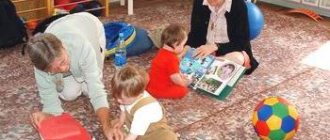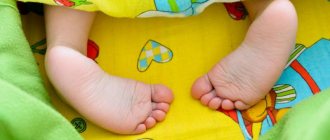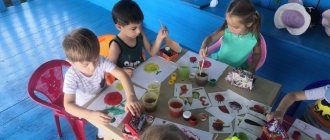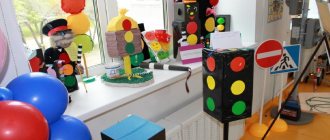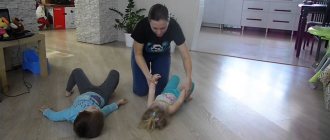Club work at preschool educational institutions
First, I would like to talk in general about what place circle work occupies in the activities of a kindergarten, why it is needed, what goals it pursues and how it is organized.
So, any planning of a group’s work for the year includes the inclusion in the plan of various clubs in which children will study in addition to the general main load of compulsory classes. This is the so-called variable part of the program.
The wide selection of clubs in kindergarten today will amaze even the most demanding parent. However, despite the variety of thematic areas, all circles are organized and function according to the same patterns.
A circle is the bringing together of children in a group for activities based on a common interest. When choosing a topic for a circle, the interests and needs of children, as well as the wishes of parents, are taken into account, which can be found out through conversations, consultations, surveys and parent-teacher meetings. And, as mentioned above, within the circle, children are taught material that goes beyond the standard of preschool education.
Functions of clubs in kindergarten:
- educational;
- socially adaptive;
- correctional and developmental;
- educational.
Clubs are organized in kindergarten with the following goals:
- to deepen and expand the knowledge acquired through basic education;
- to become familiar with knowledge that is not included in the state program (for gifted children);
- for the development of skills that develop self-knowledge, self-development, self-regulation, and interpersonal communication skills.
When carrying out circle work, the teacher must find the right emotional wave in order to interest children in the proposed activity. Communication should occur easily and naturally, bringing pleasure to both the teacher and the children.
At the same time, it is important to take into account such conditions as convenient organization of the workspace, activities for children based on their strengths and interests, and presentation of material in the form of a game.
Club work with children is carried out in the form of frontal group classes, excursions, walks, entertainment events and competitions.
As a rule, circles are organized in the following four areas:
- physical development;
- social - personal development;
- cognitive and speech development;
- artistic and aesthetic development.
How to organize circle work in the middle group of kindergarten
Club work in kindergarten is necessary to help the child discover his individual aspirations and inclinations, as well as learn to express himself in various types of creative activities. It is important for the teacher to know how to organize circle activities in the middle group of a kindergarten (pupils 4–5 years old). Let's look at the various stages of organizing the educational process and tell you how to choose the type of circle and plan its work, how to draw up a work program, technical maps and lesson notes, how to play with a variety of topics and draw up a report on the work of the circle for the year.
Circles in the middle group
What directions and topics should we take for the middle group? I will say right away that long-term planning, as a rule, provides for several areas of activity that a kindergarten can offer based on the availability of teaching staff and logistics.
Since at this age all children love to make crafts, a circle called “Skillful Hands” would be an absolutely win-win option. Creative manual labor allows you to develop sensorimotor skills, improve coordination of movements, develops the child’s mental development and thinking, fosters independence, confidence and initiative. In such a circle, activities are carried out on working with paper and cardboard, including such areas as origami, with fabric and thread, natural and waste materials.
It is also quite possible to offer a circle on ecology and call it, for example, “Visiting Nature.” In preschool education, the ecological-biological direction allows you to understand nature, develop a humane attitude towards it and learn to consciously behave in the natural environment.
A child aged 4-5 years is a “why” who is interested in cause-and-effect relationships in living and inanimate nature. In order for children to get answers to all their questions, you can conduct excursions with observations, didactic games, quizzes and competitions, solve riddles, read literary works and have conversations with them.
Also in this matter, practical methods of consolidating the learned material will be relevant: designing a herbarium, theatrical activities in the form of staging fairy tales and individual skits, making visual aids together with children.
If we consider the long-term plan for the work of a drawing circle, then we can offer many interesting techniques that are not provided for in the general education curriculum. The objectives of this circle are to get acquainted with non-traditional drawing techniques, use a wide variety of materials, get acquainted with different genres of fine art, develop in children a sense of form, color, proportion, as well as cultivate an aesthetic attitude towards the world around them.
Within the framework of this circle, you can teach children to draw with fingers, cotton swabs, make impressions with crumpled paper and imprints with leaves, master pointillism (drawing with dots), drawing with palms, cotton pads, toothpaste, blowing with a tube and much more, including such a direction as plasticineography.
Middle group. Junior preschool age. Children 4 - 5 years old
Circle work on appliqué using non-traditional techniques in the middle group “Fur coat for a sheep”
In the middle group "Barbariki"
A group work was carried out on non-traditional drawing techniques.
The goal was to introduce children to the elements of the cotton wool technique: tear small pieces from a large lump, crumple small pieces of cotton wool into lumps and glue them onto the silhouette of a sheep. Develop... Photo report on productive activities in the middle group in constructing “New Year’s garland” from circles and strips of paper
New Year's holidays are approaching and with them the hassle of decorating group rooms. The middle group children made New Year's garlands from strips of double-sided colored paper and balls from two identical circles . Of course, it could be purchased at a specialized...
Methodical piggy bank
Thus, you see that the middle group of kindergarten offers the widest scope for choosing circle work. If parents wish, you can also offer a math group, or, for example, an English language group, organize a dance group, or show a puppet theater.
The main thing is that you are competent in the field of activity that you are applying for. Or clubs can be taught by other specialists, if there are any in the kindergarten, for example, dance or English.
To help you, there are teaching aids and recommendations for conducting classes that will help present the material in a beautiful and interesting form:
- “Artistic and aesthetic development of children 5-6 years old. Plasticineography classes";
- "Children's design. Plasticinography" and "Plastilinography 2";
- “Take care of the living. Game didactic material on ecology for children from 4 years old";
- “Theatrical activities in preschool educational institutions. Scenarios based on fairy tales of foreign writers and peoples of the world";
- “Artistic work in kindergarten. Middle group. Lesson notes and methodological recommendations."
And, tell us, dear teachers, what clubs are there in your kindergartens, which of them are the most popular? Parents can also take part in the survey and write what they would most like to do with their children in the garden. Maybe there are some new directions that I don’t know about yet. In general, share everything you know.
Don’t forget to like the article on social networks and subscribe to blog updates. We have a lot of interesting things ahead of us.
Sincerely, Tatyana Sukhikh! Till tomorrow!
By the way, I recommend reading:
Theoretical aspects of organizing circle work in the middle group of preschool educational institutions
Like the entire modern education system, the upbringing and education of preschool children are products of an industrial society. This means that they are designed for a flow process, a conveyor belt, in which children, just like blanks, are divided into groups according to common characteristics and are exposed to certain standard educational procedures. The dependence of the educational process on centrally approved programs, rigid general plans and standards is a striking sign of such a system. In such conditions, the question arises of how to help a child preserve and develop his own individuality, what to do if children are very similar in some ways, but very different from each other in others. Group work with preschoolers often requires adjustments and additions, taking into account differences in the development of children and differences in their personal motivation.
Club work in a preschool institution is a form of activity that allows for an individual approach to each child and leaves children with more creative freedom and opportunities to develop their abilities.
Club activities in preschool educational institutions contribute to the development of various useful skills and abilities in children, as well as creative self-realization
The goals of circle work can be varied, because the integration of various educational areas is one of the strengths of such work. In this case, it is necessary to take into account the characteristics of pupils of middle preschool age. In psychology, it is generally accepted that children aged 4–5 years are characterized by the following areas of search activity:
Important! Pay attention to the last aspect, it imposes some responsibility on parents and educators, and deliberately ignoring his first, still timid manifestations of interest in some kind of play or cognitive activity can become a great trauma for the child.
When organizing club activities, it is important to take into account the interests of students
An approximate list of goals for club activities in the middle group of kindergarten:
The goal of the environmental circle at the preschool educational institution is to foster a caring attitude towards nature
The participation of preschoolers in various club activities is not only a way to organize children's leisure time, but also helps students expand the range and available methods of communication, develop a sense of responsibility for their actions, increase self-esteem and find new interesting activities for themselves.
Methods and techniques
Possible methods and techniques for conducting club classes in preschool educational institutions include the following:
Directions of circle activities in the middle group
Various types of clubs can be organized in kindergarten. The range of available classes will be determined by the immediate interests and capabilities of children and parents, the financial and technical capabilities of the child care institution to organize this or that type of classes, as well as the ability of the teaching staff to provide work in certain areas. However, the variety of children's activities is so great that in any kindergarten it is possible to organize the work of at least several clubs without any problems. We list the popular types of clubs and possible areas of club activities in the middle group of kindergarten:

